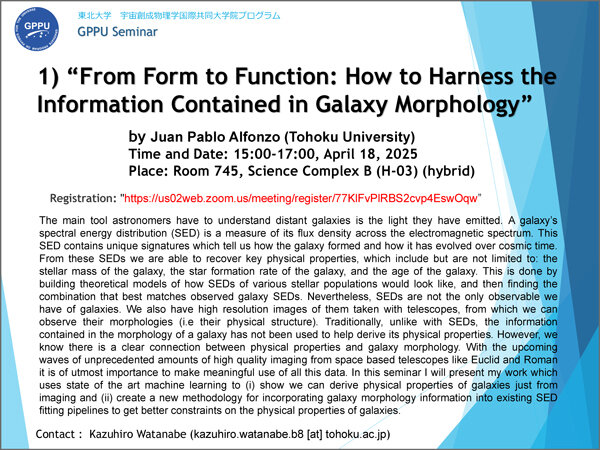お知らせ

- トップ
- お知らせ
GP-PUセミナー開催のご案内
4月18日(金)、以下の内容にて宇宙創成物理学国際共同大学院(GP-PU)セミナーを開催いたします。
■日 時
2025年4月18日(金)15:00-17:00
■セミナー題目
1) From Form to Function: How to Harness the Information Contained in Galaxy Morphology
by Juan Pablo Alfonzo (Tohoku University)
The main tool astronomers have to understand distant galaxies is the light they have emitted. A galaxy's spectral energy distribution (SED) is a measure of its flux density across the electromagnetic spectrum. This SED contains unique signatures which tell us how the galaxy formed and how it has evolved over cosmic time. From these SEDs we are able to recover key physical properties, which include but are not limited to: the stellar mass of the galaxy, the star formation rate of the galaxy, and the age of the galaxy. This is done by building theoretical models of how SEDs of various stellar populations would look like, and then finding the combination that best matches observed galaxy SEDs. Nevertheless, SEDs are not the only observable we have of galaxies. We also have high resolution images of them taken with telescopes, from which we can observe their morphologies (i.e their physical structure). Traditionally, unlike with SEDs, the information contained in the morphology of a galaxy has not been used to help derive its physical properties. However, we know there is a clear connection between physical properties and galaxy morphology. With the upcoming waves of unprecedented amounts of high quality imaging from space based telescopes like Euclid and Roman it is of utmost importance to make meaningful use of all this data. In this seminar I will present my work which uses state of the art machine learning to (i) show we can derive physical properties of galaxies just from imaging and (ii) create a new methodology for incorporating galaxy morphology information into existing SED fitting pipelines to get better constraints on the physical properties of galaxies.
2) Cosmic very small dust grains as a natural laboratory of mesoscopic physics
by Kenji Amazaki (Tohoku University)
When viewed from Earth, the entire sky is covered by Galactic interstellar dust, which absorbs, scatters, and re-emits light across a broad spectral range from millimeter waves to ultraviolet. Among these, nanoscale very small grains (VSGs)--containing 10² to 10⁴ atoms--are "mesoscopic" systems with unique thermal and optical properties. For example, at low temperatures, the quantization of energy levels limits the number of thermally accessible states, making it difficult to describe thermal properties using the conventional thermodynamical temperature. In this study, we construct a new emission model for carbonaceous VSGs by incorporating mesoscopic physics. We applied the method of energy level statistics to account for the effect of free electrons, which contribute to the thermal emission at low temperatures. We found that the spectral energy distribution of carbonaceous VSGs exhibits an excess emission at wavelengths beyond the submillimeter range. The observational implications of this result will be discussed. Interstellar dust--being extremely cold and isolated--provides an ideal environment to study mesoscopic physics. The future high-precision observational data will enable us to explore the detailed properties of interstellar dust tha
t have previously been overlooked.
■開催形式
対面×オンライン(Zoom)併用
[対面会場] 理学研究科合同B棟745号室 (キャンパスマップ「H-03」の建物です。)
■参加登録
参加者は事前に下記URLで参加登録が必要です
https://us02web.zoom.us/meeting/register/77KlFvPlRBS2cvp4EswOqw
■Point
GSP = 1
■お問合せ
物理学専攻(GP-PU) 渡邉 和宏
E-mail: kazuhiro.watanabe.b8[at]tohoku.ac.jp
([at]を@に置き換えてください)


Posted on:2025年4月11日